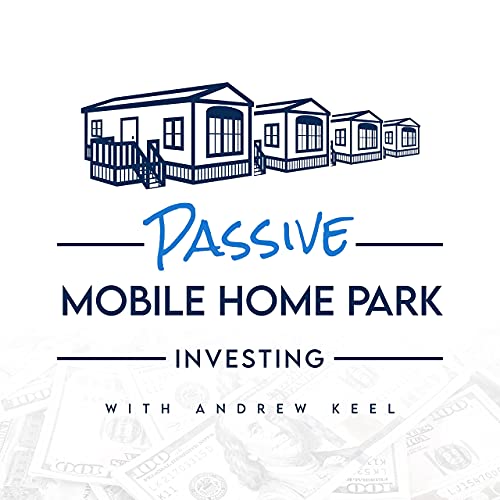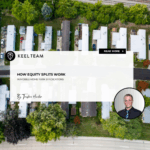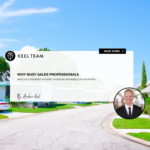The 10 Minute Mobile Home Park Deal Review
-
 Andrew Keel
Andrew Keel
Listen on Apple Podcast here: https://podcasts.apple.com/us/podcast/the-10-minute-mobile-home-park-deal-review/id1520681893?i=1000496212369
SHOW NOTES
Welcome back to the Passive Mobile Home Park Investing Podcast, hosted by Andrew Keel. On this episode of the Passive Mobile Home Park Investing Podcast, Andrew talks about how you can review a potential mobile home park investment opportunity in 10 minutes or less. Andrew goes over some great tips on where you should go for market research, rent comps and more! Andrew also goes over the most important things you need to look upfront when considering a passive mobile home park investment.
Andrew Keel is the owner of Keel Team, LLC, a Top 100 Owner of Manufactured Housing Communities with over 1,400 lots under management. His team currently manages over 20 manufactured housing communities across ten states – AR, GA, IA, IL, IN, MN, NE, OH, PA and TN. His expertise is in turning around under-managed manufactured housing communities by utilizing proven systems to maximize the occupancy while reducing operating costs. He specializes in bringing in homes to fill vacant lots, implementing utility bill back programs, and improving overall management and operating efficiencies, all of which significantly boost the asset value and net operating income of the communities.
Andrew has been featured on some of the Top Podcasts in the manufactured housing space, click here to listen to his most recent interviews: https://www.keelteam.com/podcast-links. In order to successfully implement his management strategy Andrew’s team usually moves on location during the first several months of ownership. Find out more about Andrew’s story at AndrewKeel.com.
Would you like to see mobile home park projects in progress? If so, follow us on Instagram: @passivemhpinvesting for photos and awesome videos from our recent mobile home park acquisitions.
Talking Points:
00:18 – Welcome to the Passive Mobile Home Park Investing Podcast
00:40 – The key to getting a mobile home park deal done quickly and efficiently
01:32 – Researching the market
01:55 – 5 websites, tools, and go-to places for thorough research
05:32 – FEMA Flood Map
06:22 – Occupancy in the mobile home community
07:19 – The number of park-owned homes in the community
08:00 – The utility infrastructure
09:15 – Review the size of the lots and the park
10:47 – Pitched roof homes
11:23 – Lot rent competition in the area
12:04 – Conclusion
SUBSCRIBE TO PASSIVE MOBILE HOME PARK INVESTING PODCAST YOUTUBE CHANNEL https://www.youtube.com/channel/UCy9uI3KGQmFgABsr9lUtRTQ
Resources/Links:
BestPlaces.net: https://www.bestplaces.net/
SpotCrime.com: https://spotcrime.com/
GreatSchools.org: https://www.greatschools.org/
RentOMeter.com: https://www.rentometer.com/
FEMA Flood Maps: https://msc.fema.gov/portal/home
Links & Mentions from This Episode:
Bigger Pockets Website: https://www.biggerpockets.com/
Mobile Home University Website: https://www.mobilehomeuniversity.com/
Keel Team’s Official Website: https://www.keelteam.com/
Andrew Keel’s Official Website: https://www.andrewkeel.com/
Andrew Keel LinkedIn: https://www.linkedin.com/in/andrewkeel
Andrew Keel Facebook Page: https://www.facebook.com/PassiveMHPin…
Andrew Keel Instagram Page: https://www.instagram.com/passivemhpi…
Twitter: @MHPinvestors
TRANSCRIPT
Welcome to the Passive Mobile Home Park Investing Podcast with your host Andrew Keel. This is the podcast where you can get the education you need to invest 100% passively in a highly profitable niche of mobile home parks.
Hello and welcome to this episode of the Passive Mobile Home Park Investing Podcast. This is your host, Andrew Keel. Today, we are going to discuss how you can review a potential mobile home park investment opportunity in 10 minutes or less. That’s right. After this episode, you will have the go-to list of the top things you need to look at first before spending any additional time completing due diligence on the operator, deal terms, et cetera.
This is more geared towards property-specific syndication investments that give you, as an investor, the opportunity to research the tangible real estate being purchased upfront, prior to agreeing to make any investment.
Before we dive in, it’s important to note that this is not the end-all, be-all list for researching a potential mobile home park deal that you might invest in. This is simply a starting point that will allow you to decide quickly if you should spend any additional time on this specific opportunity.
First things first, you’re going to want to research the market. You can change a lot about a specific piece of real estate through value-add initiatives and an attractive purchase price. However, the surrounding market demographics are going to be outside of your control.
When researching the market, here are five, quick things that you’re going to want to look at first.
Number one is bestplaces.net. You want to look at a few statistics from this website. But first, we look at the population of the city and the metro itself. You should aim to be in metros with at least a 50,000 or higher population.
You also want to see a median home price above $100,000. Future job growth and income growth above the national averages are great metrics as well as to the market’s future capabilities.
Also, housing appreciation being up and positive over the last five years is a great metric, because that is likely pricing people out of stick-built houses.
Number two when researching the market, you should check out the top employers in the area. This is a big one, because you’re inadvertently making a bet that these top employers are going to do well moving forward with an investment into this piece of real estate.
An easy process starts with you going to Google and simply typing in ‘top employers in blank.’ You can insert the city and state name, or the county and state name to try and pull up a list of the top employers in the area. Most areas will have a chamber of commerce website with a page dedicated specifically to this top employer list. Once you find the list, check out the top five employers and how many employees each of them employ. You also want to check out what sectors they’re in.
If they’re diversified across say healthcare, government, manufacturing, and education, this is a very positive note for the area. However, if you see one large employer with over 50% of the workforce, this is a huge gamble on this company doing well into the foreseeable future. You need to be aware of that upfront.
For example, if there was one big car manufacturer in town and it is the employer for over 50% of the local citizens, and something outside of your control happens to this business, it could drastically affect your tenant base more than an area with diverse employment options would.
Number three when you’re looking at the market, you’re going to want to check out the crime rate. We do this at spotcrime.com. This is a great website, you can even sign up for alerts to notify you when crimes happen near the subject property. High crime areas increase your risk and lower the overall quality of tenants you’re able to attract in your community. Also, these high crime properties will be much more management-intensive.
After that, we check out the school ratings for the market on greatschools.org. In order to be a desirable area for families, the local public school ratings should be at a grade of at least 6 out of 10 or better.
Number five in terms of checking out the market, we look at the local three bedroom rental prices on rentalmeter.com. If these rental rates are above $1000 a month, your lot rent numbers will, more than likely, have room to grow into the foreseeable future. This is a great metric to tell that.
Once you’re satisfied with the first five items—researching the market—the next thing we do is we go to Google and type in ‘FEMA Flood Map.’ This is a deal killer if it comes back negative. We’ll type in the address of the community and hit search. If 20% or more of the subject mobile home park is in the 100-year floodplain, you might want to consider walking away from this deal.
Mobile homes made post-1978 are resilient due to the HUD building standards set up at that time. However, water can cause irreversible damage. Most residents won’t carry the insurance necessary to cover the replacement cost on their homes in the event of a flood.
Next up, we do a quick audit of the income and occupancy in the mobile home community. More often than not, low occupancy is due to poor management. However, you should make sure that you’re okay with the risks involved with large infill projects that involve 50% vacancy or higher at the time of acquisition.
A quick income audit will also tell you if the income history is consistent or not. To do this, you can simply take the number of occupied lots and multiply that by the monthly lot rent amount, and then times that number by 12 for the 12 months in a year. This number should be within the 20%–25% of the gross income number listed on the seller’s trailing 12-month financial report. If it’s not, something is up, and the inconsistency should be a red flag right away.
After that, you should review the number of park-owned homes in the community. If the number of park-owned homes is higher than 30%, the property will more than likely have a higher expense ratio because of that. Some operators live by the park-owned home model. However, we found that the repairs on park-owned homes are just one of the harder items to pro forma for prior to purchase.
You just never know when a tenant is going to get up and leave. This turnover can cause your expenses to skyrocket. That’s why we avoid trying to go after fully park-owned home communities.
After that, review the utility infrastructure that the operator mentions in the explanation of the subject property. This is very important. Are the water in sewer utilities private or public? The ideal setup is public utilities, meaning that the community is on city-maintained water and sewer services.
Private utilities like well water and septic tanks require more oversight. With wells, there’s specific testing that’s required to ensure that the management is not poisoning the entire community with too much or too little chemicals, like chlorine for example.
Septic tanks and wastewater treatment plants also require additional professionals needed to maintain these systems. With that comes additional expenses. Most private sewer systems also have the potential to fail at their 50-year life expectancy. You want to make sure that the operator is aware of this, because these can be capital-heavy risks. If you have to replace one of these systems, it can get into the six-figure mark.
Reviewing the size of the mobile homes and the size of the lots are the next important items you want to review. Most mobile home parks were built 50 or more years ago. The factory-built homes that were built 50 years ago were a lot different from today’s homes that are being built. Some of these older homes were built as tiny homes and were built 12-foot wide.
In today’s world, these homes are the hardest to occupy when they go vacant due to the average family size being much larger nowadays. New homes being built are definitely bigger. Most of the time, newer homes are up to 16-foot wide and 70–80-foot long. If the community you’re looking to invest in has small lots, these new homes coming out of the factories today just won’t fit. As your older inventory dissolves, it will present a challenge to keep occupancy levels high.
I recommend that you get the address of the community and type it into Google Maps. Then, try to drive down the streets of the community or along the front entrance of the subject mobile home community right there from your computer. This will tell you a lot about the community, including the size of homes and lots, the average age of the mobile homes in the community, and the types of road infrastructure making up the general appeal of the park.
A tip here is that pitched roof homes were manufactured primarily during or after the 1980s—after the HUD building standards were put into place in 1978. These homes are of better quality and are more durable to withstand the turn over from one home owner to the next.
Also, lenders love to see well-maintained, paved roads. Better financing options will more than likely be available to communities that have this nice amenity.
Last but not least, I recommend that you check out the lot rent comps in the area if these are available and provided by the operator. Having this data is invaluable. Engage in the competition of other mobile home communities in the area. Once you see what the other communities are charging for rent, hop on Google Maps again and do a drive-through of those communities. Give each community a quick A, B, or C grade compared to the subject property. If the subject property is in better condition than the comp properties but is charging less for lot rent, this could bode well for investors involved in this deal.
Anyway, that’s it for today. Make sure to tune in next week, on Tuesday, for an interview with fund manager and opportunity zone expert, Mr. Sam Hales, with the Saratoga Group.
Also, please make sure to leave this show a quick five-star review on iTunes if you’re getting value out of it. Chances are that, if you’ve made it this far in the podcast, you must like something, so please share this with me so that I know. Anyway, until next time. Thank you so much for tuning in.
Would you like to see mobile home park value-add projects in progress? If so, follow us on Instagram, @passivemhpinvesting for photos and awesome videos from our recent mobile home park acquisitions. Once again, that’s @passivemhpinvesting on Instagram. See you there.
Andrew Keel
View The Previous or Next Post
Subscribe Below 👇




